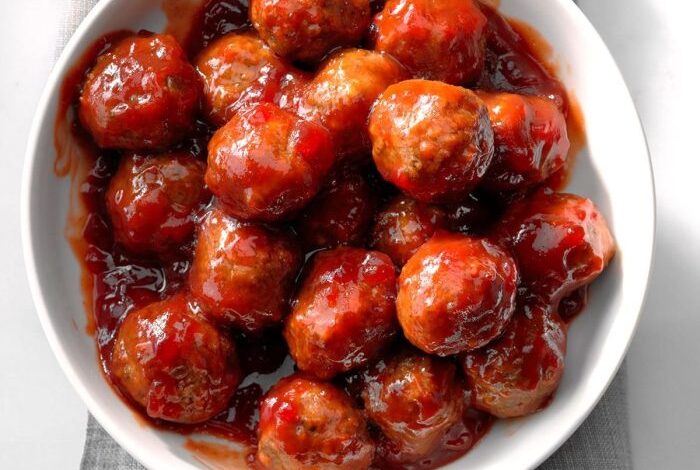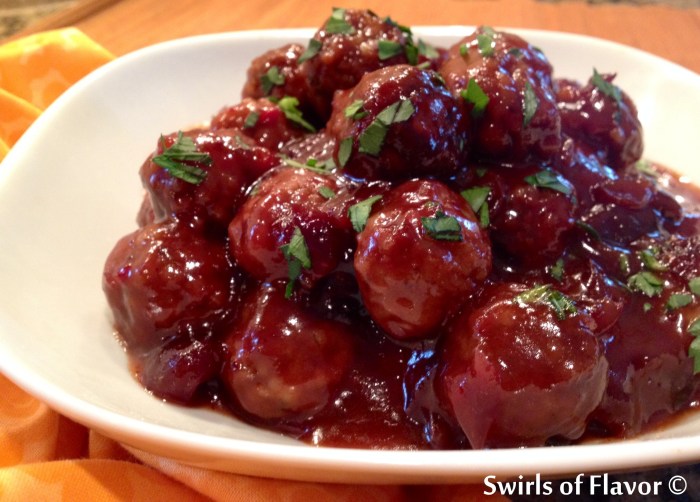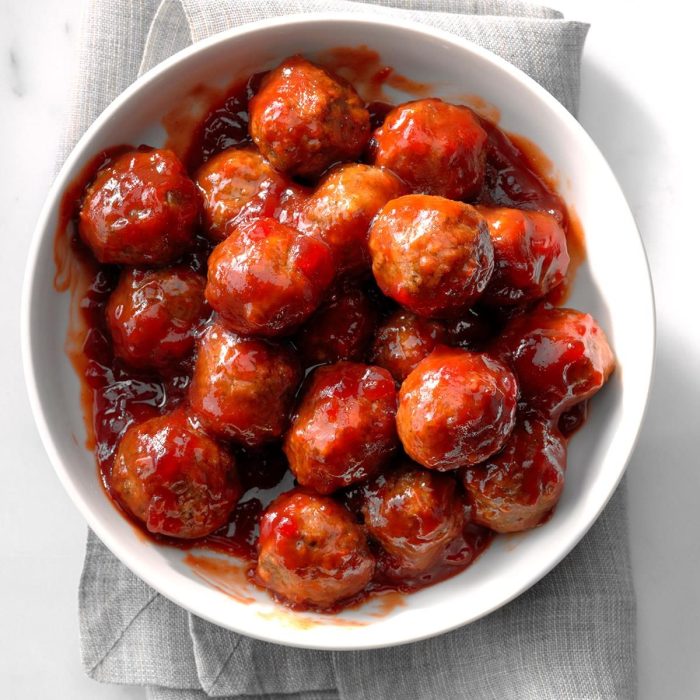
Vegetarian Sweet and Sour Meatballs: A Flavorful Plant-Based Delight
Vegetarian sweet and sour meatballs are a delicious and satisfying dish that brings together the best of both worlds: the hearty texture of plant-based protein and the tangy sweetness of a classic sauce. These meatballs are a delightful alternative to their meaty counterparts, offering a flavorful and nutritious experience that’s perfect for any occasion.
This blog post delves into the exciting world of vegetarian sweet and sour meatballs, exploring the diverse options for creating these flavorful bites. We’ll cover everything from choosing the perfect protein source to mastering the art of crafting the perfect sweet and sour sauce.
We’ll also provide tips for adapting this recipe to fit different dietary needs and explore creative serving suggestions that will elevate your culinary game.
Vegetarian Meatball Variations

The beauty of vegetarian meatballs lies in their versatility. You can create a wide array of flavors and textures by experimenting with different plant-based protein sources. From hearty lentils to creamy tofu, each ingredient brings its own unique character to the table.
Lentils: Earthy and Hearty
Lentils are a powerhouse of protein and fiber, making them an excellent choice for vegetarian meatballs. Their earthy flavor pairs well with a variety of spices and sauces. When cooked, lentils become soft and slightly mushy, creating a satisfyingly dense texture that holds its shape well.
“Lentils are a good source of protein, fiber, and iron, making them a healthy and satisfying addition to any diet.”
[Source
Healthline]
Here’s a simple recipe for lentil meatballs: Ingredients:* 1 cup brown lentils, cooked
- 1/2 cup finely chopped onion
- 1/4 cup chopped fresh parsley
- 1 clove garlic, minced
- 1/4 cup breadcrumbs
- 1 egg
- 1 tablespoon olive oil
- Salt and pepper to taste
Instructions:
- In a large bowl, combine all ingredients and mix well.
- Form the mixture into small meatballs.
- Heat the olive oil in a skillet over medium heat.
- Cook the meatballs for 5-7 minutes per side, or until golden brown and cooked through.
Chickpeas: Creamy and Nutty, Vegetarian sweet and sour meatballs
Chickpeas, also known as garbanzo beans, offer a creamy and nutty flavor that adds a delightful dimension to vegetarian meatballs. Their texture is soft and slightly grainy, creating a unique mouthfeel.
“Chickpeas are a good source of protein, fiber, and iron, and they are also a good source of folate, manganese, and phosphorus.”
[Source
Medical News Today]
Here’s a recipe for chickpea meatballs: Ingredients:* 1 can (15 ounces) chickpeas, drained and rinsed
- 1/4 cup chopped onion
- 1/4 cup chopped fresh cilantro
- 1 clove garlic, minced
- 1/4 cup breadcrumbs
- 1 tablespoon olive oil
- Salt and pepper to taste
Instructions:
- In a food processor, pulse the chickpeas until finely chopped, but not completely smooth.
- Add the remaining ingredients and pulse until well combined.
- Form the mixture into small meatballs.
- Heat the olive oil in a skillet over medium heat.
- Cook the meatballs for 5-7 minutes per side, or until golden brown and cooked through.
Tofu: Versatile and Adaptable
Tofu, a soy-based product, is incredibly versatile and easily absorbs flavors. Its texture can range from firm to silken, depending on the type you choose. Firm tofu is ideal for meatballs, as it holds its shape well and provides a satisfyingly meaty texture.
“Tofu is a good source of protein, iron, and calcium, and it is also low in calories and fat.”
[Source
The Vegan Society]
Here’s a recipe for tofu meatballs: Ingredients:* 1 block (14 ounces) firm tofu, drained and pressed
- 1/4 cup chopped onion
- 1/4 cup chopped fresh mushrooms
- 1 clove garlic, minced
- 1/4 cup breadcrumbs
- 1 tablespoon soy sauce
- 1 tablespoon olive oil
- Salt and pepper to taste
Instructions:
- Crumble the tofu into a large bowl.
- Add the remaining ingredients and mix well.
- Form the mixture into small meatballs.
- Heat the olive oil in a skillet over medium heat.
- Cook the meatballs for 5-7 minutes per side, or until golden brown and cooked through.
Tempeh: Fermented and Flavorful
Tempeh, another soy-based product, is fermented, giving it a unique earthy and nutty flavor. Its texture is firm and slightly chewy, adding a delightful bite to vegetarian meatballs.
“Tempeh is a good source of protein, fiber, and iron, and it is also a good source of B vitamins and manganese.”
[Source
The Vegetarian Resource Group]
Here’s a recipe for tempeh meatballs: Ingredients:* 1 block (8 ounces) tempeh, crumbled
- 1/4 cup chopped onion
- 1/4 cup chopped fresh ginger
- 1 clove garlic, minced
- 1/4 cup breadcrumbs
- 1 tablespoon soy sauce
- 1 tablespoon olive oil
- Salt and pepper to taste
Instructions:
- In a large bowl, combine all ingredients and mix well.
- Form the mixture into small meatballs.
- Heat the olive oil in a skillet over medium heat.
- Cook the meatballs for 5-7 minutes per side, or until golden brown and cooked through.
Sweet and Sour Sauce Variations

Sweet and sour sauce is a staple in many cuisines, especially Asian-inspired dishes. It’s a versatile sauce that can be used to glaze meat, vegetables, and even tofu. The sweet and sour flavors create a delightful contrast that is both savory and tangy.
Traditional Components of Sweet and Sour Sauce
The foundation of a classic sweet and sour sauce lies in its essential components: vinegar, sugar, soy sauce, and cornstarch. * Vinegar:Provides the tangy element, with rice vinegar being the most common choice.
Vegetarian sweet and sour meatballs are a delicious and easy dish to make, and they’re a great way to get your veggies in. I love the tangy, sweet sauce and the satisfying texture of the meatballs. If you’re looking for a similar dish with a slightly different flavor profile, you might want to try cashew chicken with water chestnuts.
It’s a classic Chinese takeout favorite, and it’s surprisingly easy to make at home. But for a vegetarian option, those sweet and sour meatballs are definitely the way to go!
Sugar
Balances the acidity of the vinegar with sweetness.
Soy Sauce
Adds a savory depth of flavor and saltiness.
Cornstarch
Creates a thickening agent, resulting in a smooth and glossy sauce.
Common Flavor Profiles
Sweet and sour sauces can be tailored to create diverse flavor profiles, catering to various culinary preferences. Here are some common variations:* Classic Chinese Sweet and Sour Sauce:This is the most common version, featuring a balance of sweet, sour, and salty flavors. The sauce is typically made with rice vinegar, sugar, soy sauce, and cornstarch.
Hawaiian Sweet and Sour Sauce
This variation often incorporates pineapple juice, giving it a tropical twist. It may also include a hint of ginger and chili flakes for added complexity.
Thai Sweet and Sour Sauce
This sauce leans towards a spicier profile, incorporating ingredients like fish sauce, lime juice, and chilies.
Recipes for Sweet and Sour Sauce Variations
Here are some recipes that showcase different fruit, spice, and herb combinations, allowing you to explore the diverse world of sweet and sour sauces:* Mango Sweet and Sour Sauce:This variation features the tropical sweetness of mango, paired with the tanginess of lime juice.
Ingredients
1 cup mango puree
1/4 cup lime juice
1/4 cup soy sauce
1/4 cup sugar
1 tablespoon cornstarch
Vegetarian sweet and sour meatballs are a great option for a light and flavorful meal. They’re packed with veggies and a tangy sauce that’s sure to please everyone. If you’re looking for a more decadent option, you might want to try caramel apple pork chops.
But for a vegetarian-friendly dish that’s both satisfying and healthy, vegetarian sweet and sour meatballs are definitely worth a try.
1/2 teaspoon ginger, grated
Instructions
Combine all ingredients in a saucepan.
Bring to a boil, then reduce heat and simmer for 5 minutes, or until thickened.
Cherry Sweet and Sour Sauce
This sauce uses tart cherries to add a bright, fruity dimension.
Ingredients
1 cup pitted cherries
1/4 cup apple cider vinegar
1/4 cup brown sugar
1 tablespoon cornstarch
1/4 teaspoon cinnamon
Instructions
Combine all ingredients in a saucepan.
Bring to a boil, then reduce heat and simmer for 5 minutes, or until thickened.
Strawberry Sweet and Sour Sauce
This sauce uses strawberries to add a vibrant red color and a touch of sweetness.
Ingredients
1 cup strawberries, chopped
1/4 cup white wine vinegar
1/4 cup honey
1 tablespoon cornstarch
1/4 teaspoon ground cardamom
Instructions
Combine all ingredients in a saucepan.
Bring to a boil, then reduce heat and simmer for 5 minutes, or until thickened.
Vegetarian Meatball Preparation Techniques: Vegetarian Sweet And Sour Meatballs

Creating delicious vegetarian meatballs is a culinary adventure that requires careful attention to ingredient selection and preparation techniques. The goal is to achieve a flavorful, satisfying, and visually appealing meatball that complements the sweet and sour sauce perfectly.
Combining Ingredients
To create a cohesive and flavorful vegetarian meatball, the chosen ingredients must be blended harmoniously. This typically involves combining a base of finely chopped vegetables, such as onions, carrots, and celery, with protein sources like lentils, chickpeas, or tofu. These ingredients provide the foundation for the meatball’s texture and flavor.
- Pulse, Don’t Grind: Pulsed ingredients retain a bit of texture, contributing to a more satisfying bite. This technique prevents the meatballs from becoming overly dense and mushy.
- Bind with Purpose: Binding agents, such as breadcrumbs, oats, or flaxseed meal, help hold the ingredients together. These agents absorb moisture, ensuring the meatballs maintain their shape during cooking.
- Flavor Enhancement: Incorporating spices, herbs, and flavorful additions like soy sauce, nutritional yeast, or a splash of vegetable broth adds depth and complexity to the meatball’s taste.
Shaping the Meatballs
Once the ingredients are combined, it’s time to shape the meatballs. This step requires a light touch to avoid overworking the mixture, which can result in tough meatballs.
- Size and Shape: The size and shape of the meatballs are a matter of personal preference. Smaller meatballs tend to cook faster and are ideal for dipping in the sweet and sour sauce. Larger meatballs are suitable for serving as a main course.
- Uniformity: Consistency in size and shape ensures even cooking. This allows the meatballs to brown evenly and cook through to the center.
- Moist Hands: Slightly moistened hands prevent the mixture from sticking. This makes shaping the meatballs easier and ensures a smooth surface.
Cooking Methods
The choice of cooking method influences the texture and flavor of the vegetarian meatballs. Each method has its own advantages and considerations.
Vegetarian sweet and sour meatballs are a delightful and satisfying dish, especially when you want a meat-free option. They offer a burst of flavor and texture, with the tangy sauce complementing the soft, savory meatballs. If you’re looking for another flavorful and satisfying meal, you might want to check out this recipe for pork chops and dirty rice , a classic Southern comfort food.
Both dishes are perfect for a weeknight dinner, and they’re sure to please even the pickiest eaters. Whether you’re craving sweet and sour or a hearty Southern meal, you’re sure to find something delicious to enjoy.
Baking
Baking is a healthy and convenient method for preparing vegetarian meatballs. The oven’s dry heat allows the meatballs to cook slowly and evenly, resulting in a tender and moist interior.
- Preheat Oven: Preheating the oven to a moderate temperature, typically around 350°F (175°C), ensures that the meatballs cook through properly.
- Bake Time: The baking time will vary depending on the size of the meatballs. Smaller meatballs may take around 20 minutes, while larger meatballs may require 30 minutes or more.
- Even Distribution: Arrange the meatballs in a single layer on a baking sheet to allow for even heat circulation. This prevents the meatballs from steaming and becoming soggy.
Pan-Frying
Pan-frying delivers a crispy exterior and a tender interior. This method is ideal for creating a flavorful crust on the meatballs.
- Heat the Oil: Use a high-heat cooking oil, such as vegetable oil or canola oil, to ensure the meatballs brown quickly and develop a crispy exterior.
- Avoid Overcrowding: Avoid overcrowding the pan, as this can lead to steaming instead of browning. Cook the meatballs in batches if necessary.
- Flip Carefully: Flip the meatballs once they are golden brown on one side. This ensures even browning and prevents the meatballs from sticking to the pan.
Deep-Frying
Deep-frying results in a luxuriously crispy exterior and a tender interior. This method is often used for achieving a light and airy texture.
- Proper Temperature: Use a deep fryer or a large pot filled with oil heated to the appropriate temperature, typically around 350°F (175°C). This ensures that the meatballs cook quickly and evenly without becoming greasy.
- Short Cooking Time: Deep-fried meatballs cook quickly, typically within a few minutes. Overcooking can lead to dryness.
- Drain Excess Oil: After frying, drain the meatballs on paper towels to remove excess oil. This helps prevent the meatballs from becoming soggy and ensures a crispy texture.
Serving Suggestions
Vegetarian sweet and sour meatballs are incredibly versatile and can be enjoyed in various ways, from classic pairings to innovative combinations. Whether you’re looking for a satisfying main course or a delightful appetizer, these flavorful meatballs offer endless possibilities.
Classic Pairings
Classic pairings complement the sweet and sour flavors of the meatballs, creating a harmonious balance of tastes and textures. Here are some popular options:
- White Rice:A staple accompaniment that absorbs the delicious sauce and provides a neutral base for the meatballs.
- Fried Rice:A flavorful and satisfying option, combining the meatballs with stir-fried vegetables and rice.
- Noodles:Choose from a variety of noodles, such as egg noodles, rice noodles, or even spaghetti, to create a hearty and comforting dish.
Innovative Pairings
For a more adventurous approach, consider these innovative pairings that elevate the vegetarian sweet and sour meatballs to new heights:
- Quinoa Salad:A light and refreshing salad with quinoa, mixed greens, and a tangy vinaigrette, providing a healthy and flavorful contrast to the meatballs.
- Roasted Vegetables:Roasted vegetables, such as broccoli, carrots, or Brussels sprouts, offer a delightful combination of textures and flavors, complementing the sweet and sour sauce.
- Polenta:Creamy polenta provides a comforting base for the meatballs, creating a satisfying and elegant presentation.
Serving as Appetizers
Vegetarian sweet and sour meatballs are perfect for appetizers, offering a flavorful and convenient option for gatherings.
- Skewers:Thread the meatballs onto skewers with cherry tomatoes, bell peppers, or pineapple chunks for a colorful and visually appealing presentation.
- Cocktail Party Bites:Serve the meatballs on toothpicks with a small dollop of the sweet and sour sauce for a quick and easy appetizer.
- Miniature Bowls:Fill small bowls with a bed of rice or noodles and top with a few meatballs and sauce for a delightful individual appetizer.
Serving as Main Courses
These meatballs can be the star of the show in a variety of main courses, offering a satisfying and flavorful meal.
- Dinner Plate:Serve the meatballs with a generous portion of rice, noodles, or roasted vegetables for a complete and balanced meal.
- Bowls:Create a visually appealing bowl with a bed of quinoa, rice, or noodles, topped with the meatballs, sauce, and a sprinkle of chopped green onions or cilantro.
- Wraps:Fill tortillas or wraps with meatballs, sauce, and your favorite vegetables for a convenient and delicious meal.
Serving as Salad Toppings
Add a burst of flavor and texture to your salads with vegetarian sweet and sour meatballs.
- Asian-Inspired Salad:Combine the meatballs with a bed of mixed greens, shredded cabbage, carrots, and a tangy Asian-inspired dressing.
- Mixed Greens Salad:Top a simple mixed greens salad with meatballs and a drizzle of the sweet and sour sauce for a flavorful and satisfying addition.
- Quinoa Salad:Add the meatballs to a quinoa salad with chopped vegetables and a vinaigrette for a hearty and flavorful meal.
Dietary Considerations
Vegetarian sweet and sour meatballs offer a delicious and nutritious way to enjoy a classic dish. These plant-based meatballs are packed with protein, fiber, and essential vitamins and minerals, making them a healthy and satisfying meal option.
Adapting for Dietary Restrictions
This recipe can be easily adapted to accommodate various dietary restrictions.
Gluten-Free
To make gluten-free vegetarian sweet and sour meatballs, simply use gluten-free breadcrumbs or panko breadcrumbs in the meatball mixture. Ensure all other ingredients, such as soy sauce, are also gluten-free.
Vegan
For a vegan version, replace the eggs with a vegan egg substitute, such as flaxseed meal mixed with water or commercially available vegan egg replacements. Additionally, use a vegan-friendly soy sauce or tamari.
Low-Sodium
To reduce the sodium content, use low-sodium soy sauce or tamari. Additionally, consider reducing the amount of salt used in the recipe.
Tips for Specific Dietary Needs
Here are some additional tips for making vegetarian sweet and sour meatballs suitable for individuals with specific dietary needs:
Allergies
Ensure all ingredients are free from any allergens the individual may have. For example, if someone has a nut allergy, avoid using ingredients like peanut butter or almond flour.
Diabetes
Use a low-sugar sweet and sour sauce or adjust the amount of sugar used in the recipe. Consider using a sugar substitute like stevia or erythritol.
Weight Management
Use lean protein sources in the meatball mixture, such as lentils or tofu, and choose a low-calorie sweet and sour sauce.
Heart Health
Use heart-healthy fats like olive oil or avocado oil in the recipe. Additionally, choose a low-sodium sweet and sour sauce and avoid using excessive amounts of salt.






